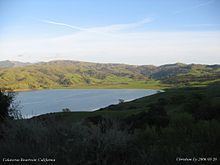Type Reservoir Surface area 1,450 acres (590 ha) Area 5.868 km² Year built 1925 | Basin countries United States Surface elevation 238 m Catchment area 254.9 km² | |
 | ||
Primary inflows Water volume 100,000 acre·ft (120,000,000 m) Inflow source Calaveras Creek, Arroyo Hondo | ||
Calaveras reservoir
Calaveras Reservoir is located primarily in Santa Clara County, California, with a small portion and its dam in Alameda County, California. The reservoir has a capacity of 100,000 acre·ft (120,000,000 m3). In Spanish, Calaveras means "skulls".
Contents
- Calaveras reservoir
- Map of Calaveras Reservoir California USA
- HistoryEdit
- Dam replacementEdit
- Plane crash discoveryEdit
- References
Map of Calaveras Reservoir, California, USA
Calaveras Reservoir is fed mainly by Arroyo Hondo and Calaveras Creek. Lying in the Calaveras Valley, the region is a geologically active area with the Calaveras Fault parallel to, and to the west of, the dam site. Because of the hazard, a replacement dam is scheduled to open in 2018. Roads adjacent to the reservoir include Calaveras Road and Marsh Road. The latter drew significant attention from a murder there in the early 1980s.
Poverty Ridge and Oak Ridge lie to the east of Calaveras Reservoir, Milpitas and Monument Peak lie to the west, Sunol lies to the far north, and Calaveras Creek and Los Buellis Hills lie to the south.
The Calaveras Valley is rich and diverse in wildlife. Some of the most common animals include deer, coyotes, squirrels, turkey vultures, red-winged blackbirds, yellow-billed magpies, red-tailed hawks, brewer's blackbirds, purple martins, barn swallows, bullock's orioles, and warblers. Since at least 2008 there has also been a regular nesting pair of bald eagles.
Calaveras reservoir
HistoryEdit
In the 19th century, the Calaveras Valley which the reservoir now fills was primarily an agricultural region known for its production of hay, strawberries, and tomatoes. Because of San Francisco's increasing demand for drinking water at the turn of the 20th century, the farmers in the region were forced to sell their land to the Spring Valley Water Company, which in turn sold it to the San Francisco Water Company.
The first dam on the site, built in 1913 by the Spring Valley Water Company, rapidly changed the sensitive hydrology and natural environment of the Calaveras Valley. It suffered a partial collapse of the upstream slope in 1918 due to engineering flaws. Its replacement, the current Calaveras Dam, was at its completion in 1925 the largest earth-fill dam in the world. It is 245 feet high, with a length of 1200 feet at its crest. The city and county of San Francisco owns and operates the dam and reservoir for municipal water supply.
The reservoir is reported to contain a very large population of largemouth bass, rainbow trout and other species. However, fishing is prohibited.
Today, the San Francisco Public Utilities Commission (SFPUC) owns 36,000 acres (150 km²) in the Alameda Creek Watershed. Some lands in the watershed are leased to livestock companies for cattle ranching to control vegetation and prevent fires. Most of the land is closed to the public because of concerns over drinking water safety and quality.
Dam replacementEdit
Because the dam is located near a seismically active fault zone and was determined to be seismically vulnerable, in 2001 the California Department of Water Resources, Division of Safety of Dams (DSOD) has restricted the reservoir to approximately 30 percent of its original capacity, 96,850 acre feet (119,460,000 m3), until the deficiencies are corrected.
The San Francisco Public Utilities Commission is constructing a new dam of equal height downstream of the existing dam as part of the $4.3 billion Water System Improvement Program. The 7 year-long environmental impact study report was certified by the San Francisco City Planning Commission on January 27, 2011. Later that day, the $434 Million Calaveras Dam Replacement Project was given the green light by the SFPUC. Excavation began in 2011 with construction on the actual dam expected to begin in 2016. The entire replacement should be complete in 2018.
The replacement effort will include several measures to aid in the restoration of native fish populations. However, construction of a fish ladder to provide Steelhead trout (Oncorhynchus mykiss) access to the waters above the dam was deemed infeasible because at 290 feet (88 m), it would be the tallest fish ladder in the country and cost $40 million. Steelhead trout have not had access to spawning streams above Calaveras Dam since 1925. However, environmentalists won concessions from the SFPUC to assure adequate water releases from the new dam to improve summer flows as well as a smaller fish ladder around a diversion dam blocking access to upper Alameda Creek, which is regarded as prime trout habitat.
Plane crash discoveryEdit
In the late 1980s and early 1990s, a drought affected California, and water levels in reservoirs throughout the state became extraordinarily low. By January 1991, the water at the reservoir was down 100 feet (30 m), and the aluminum body of an airplane became visible. Two skeletons were found at the site on January 5, 1991. Dental records and the plane's serial number were used to positively identify the remains as Clifford Gillman and his single-engine Ercoupe, along with Gillman's friend Robert Louviere. They had been missing since June 16, 1963. The wreck, minus the two men's bodies, is still lying in the center of the reservoir.
